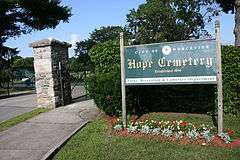Hope Cemetery (Worcester, Massachusetts)
|
Hope Cemetery | |
 | |
  | |
| Location | 119 Webster St., Worcester, Massachusetts |
|---|---|
| Coordinates | 42°14′10″N 71°49′34″W / 42.23611°N 71.82611°WCoordinates: 42°14′10″N 71°49′34″W / 42.23611°N 71.82611°W |
| Area | 168 acres (68 ha) |
| Built | 1854 |
| Architect | Earle, Stephen; Fuller & Delano, et al. |
| Architectural style | No Style Listed |
| NRHP Reference # | 97001560[1] |
| Added to NRHP | December 22, 1997 |
Hope Cemetery is an historic rural cemetery at 119 Webster Street in Worcester, Massachusetts. Established in 1854, it was the city's sixth public cemetery, and is the burial site of remains originally interred at its first five cemeteries. Its landscaping and funerary art are examplars of the rural cemetery movement, and the cemetery was listed on the National Register of Historic Places in 1997. The cemetery occupies 168 acres (68 ha).[2]
Description and history
Hope Cemetery is located in far southern Worcester, atop a rise known as Webster Hill, which has commanding views to the north and east, including the campuses of Clark University and Holy Cross College. The cemetery was laid out, probably by a landscape designer (although none has been identified), in the rural cemetery style, with winding lanes that take advantage of the terrain. It also includes horticultural plantings of note, another hallmark of the rural cemetery style, including several distinguished specimens of beech, Norway maple, sugar maple, cedar, ash, and oak trees.[3]
Worcester's first burying ground was located at Thomas and Summer Streets, and was established in 1713, and had seventeen graves marked by stone mounds, and the second burying ground, located on the Worcester Common, had more than 100 burials, all of which were relocated here in the 20th century. The third burying ground, Raccoon Plain, was a small cemetery with sixteen burials, all of which were reinterred here in 1857. The fourth burying ground, at Mechanic Street, had more than 1000 burials, which were moved here in 1878-79. The Pine Meadow Burying Ground's 658 interments were relocated here between 1862 and 1878.[3]
Notable interments
- Elizabeth Bishop, poet
- Loring Coes, inventor of the Monkey wrench
- Abby Kelley Foster, 19th century social reformer and feminist
- Stephen Symonds Foster, radical abolitionist
- Robert Goddard, rocket innovator
- John Bartholomew Gough, temperance lecturer
- Charles H. Pinkham, Medal of Honor recipient
- Thomas Plunkett, Medal of Honor recipient
- Capt. Peter Slater, youngest participant in the Boston Tea Party, site of the only memorial to the Boston Tea Party (Dec 16, 1773), fought in the American Revolution with the Continental Army
- Eli Thayer Congressman
- Webster Thayer trial judge in the Sacco and Vanzetti case
See also
- National Register of Historic Places listings in southwestern Worcester, Massachusetts
- National Register of Historic Places listings in Worcester County, Massachusetts
- Rural Cemetery (Worcester, Massachusetts), a private rural cemetery
References
- ↑ National Park Service (2008-04-15). "National Register Information System". National Register of Historic Places. National Park Service.
- ↑ Friends of Hope Cemetery
- 1 2 "NRHP nomination for Hope Cemetery". Commonwealth of Massachusetts. Retrieved 2015-09-30.
